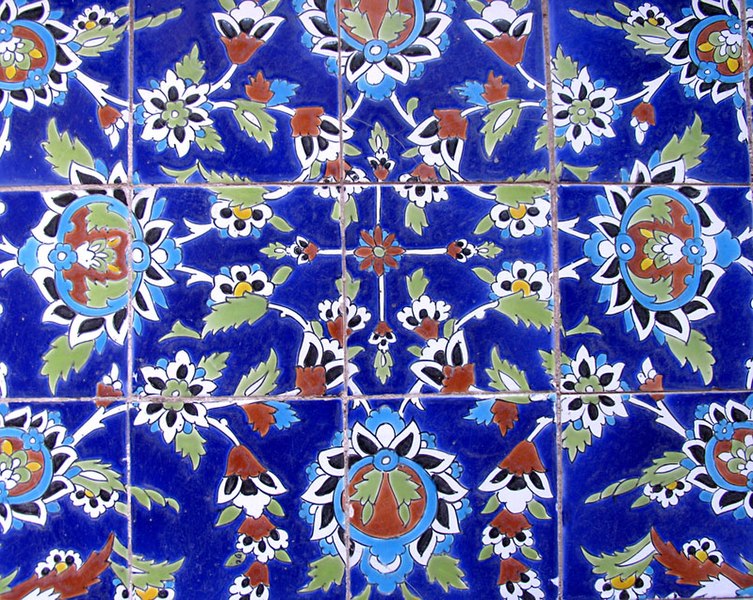File:Ali qapu palace.jpg

Original file (800 × 637 pixels, file size: 311 KB, MIME type: image/jpeg)
Captions
Captions
Summary
[edit]| DescriptionAli qapu palace.jpg |
ISFAHAN-in progress The unique blue tiles of Isfahan's Islamic buildings, and the city's majestic bridges, contrast perfectly with the hot, dry Iranian countryside around it, Isfahan is a sight you won't forget. Not only is the architecture superb and the climate pleasant, but there's a fairly relaxed atmosphere here, compared with many other Iranian towns. It's a city for walking, getting lost in the bazaar, walking in beautiful gardens and meeting people. The famous half-rhyme Isfahan nesf-e-jahan (Esfahan is half the world) was coined in the 16th century to express the city's grandeur. There's so much to see that you'll probably have to ration your time and concentrate on must-sees such as the Imam Mosque, a magnificent building completely covered in Isfahan's trademark pale blue tiles; This mosque is situated to the south of Naqsh-e-Jahan sq. built in the reign of shah Abbas, tile work and architecture of this Mosque is amazingly superb. Its minarets Are 48 meters high. Naghsh-e-Jahan (world picture) Square, one of the largest town square in the world. The Chehel Sotun Museum & Palace, a marvellous 17th century pavilion and a great place for a picnic; this palace is another building dating back to the Safavid period, built amidst a vast garden covering an area of 67000 sq m. The building has a veranda with 18 pillars and a large pool in front of it. Being mirrored in the still water of the pool, the pillars create a beautiful view. The wall painting in the interior of the building is superlative in their kind.Ali Qapoo Palace Situated to the west of Naghsh-e-Jahan Sq. belongs to the Safavid period. It was used for the reception of the Ambassadors and envoys from other Countries. Ali Qapoo is a six-storied plasterwork and paintings of which are extremely impressive. and the Vank Cathedral, the historic focal point of the Armenian church in Iran. Taking tea in one of the teahouses under the bridges is also an essential part of the Isfahan experience. Isfahan is about 400km (250mi) south of Teheran. |
| Date | |
| Source | Isfahan/ Ali Qapu Palace |
| Author | A. RB from Iran |
Licensing
[edit]- You are free:
- to share – to copy, distribute and transmit the work
- to remix – to adapt the work
- Under the following conditions:
- attribution – You must give appropriate credit, provide a link to the license, and indicate if changes were made. You may do so in any reasonable manner, but not in any way that suggests the licensor endorses you or your use.
| This image was originally posted to Flickr by HORIZON at https://www.flickr.com/photos/18467921@N00/152719503. It was reviewed on 5 May 2008 by FlickreviewR and was confirmed to be licensed under the terms of the cc-by-2.0. |
5 May 2008
File history
Click on a date/time to view the file as it appeared at that time.
| Date/Time | Thumbnail | Dimensions | User | Comment | |
|---|---|---|---|---|---|
| current | 01:42, 5 May 2008 |  | 800 × 637 (311 KB) | Kimse (talk | contribs) | {{Information |Description= ISFAHAN-in progress The unique blue tiles of Isfahan's Islamic buildings, and the city's majestic bridges, contrast perfectly with the hot, dry Iranian countryside around it, Isfahan is a sight you won't forget. Not only is the |
You cannot overwrite this file.
File usage on Commons
There are no pages that use this file.
File usage on other wikis
The following other wikis use this file:
- Usage on bg.wikipedia.org
- Usage on de.wikipedia.org
- Usage on en.wiktionary.org
- Usage on it.wikipedia.org
- Usage on lt.wikipedia.org
- Usage on ru.wikipedia.org
- Usage on zh.wiktionary.org
Metadata
This file contains additional information such as Exif metadata which may have been added by the digital camera, scanner, or software program used to create or digitize it. If the file has been modified from its original state, some details such as the timestamp may not fully reflect those of the original file. The timestamp is only as accurate as the clock in the camera, and it may be completely wrong.
| Camera manufacturer | Canon |
|---|---|
| Camera model | Canon PowerShot Pro1 |
| Exposure time | 1/25 sec (0.04) |
| F-number | f/2.4 |
| Date and time of data generation | 16:24, 18 May 2006 |
| Lens focal length | 8.125 mm |
| Orientation | Normal |
| Horizontal resolution | 180 dpi |
| Vertical resolution | 180 dpi |
| Software used | Adobe Photoshop CS Windows |
| File change date and time | 01:07, 25 May 2006 |
| Y and C positioning | Centered |
| Exif version | 2.21 |
| Date and time of digitizing | 16:24, 18 May 2006 |
| Image compression mode | 5 |
| APEX shutter speed | 4.65625 |
| APEX aperture | 2.53125 |
| APEX exposure bias | 0 |
| Maximum land aperture | 2.53125 APEX (f/2.4) |
| Metering mode | Pattern |
| Flash | Flash did not fire, compulsory flash suppression |
| Color space | sRGB |
| Focal plane X resolution | 9,406.3400576369 |
| Focal plane Y resolution | 9,415.3846153846 |
| Focal plane resolution unit | inches |
| Sensing method | One-chip color area sensor |
| Custom image processing | Normal process |
| Exposure mode | Auto exposure |
| White balance | Auto white balance |
| Digital zoom ratio | 1 |
| Scene capture type | Standard |